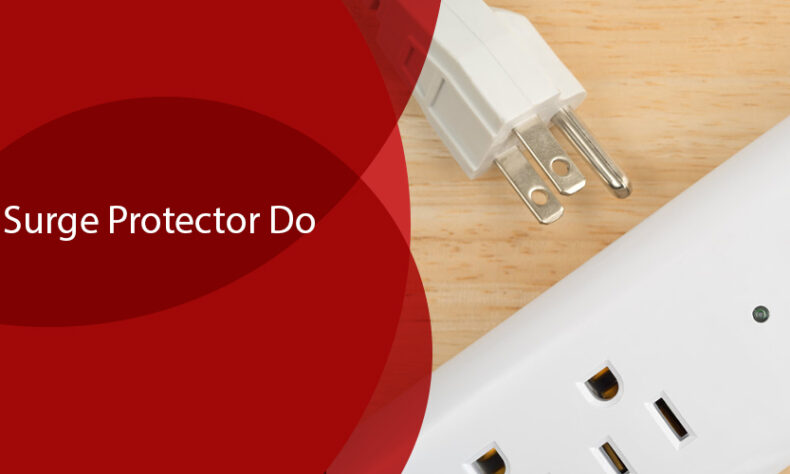
Along with many other devices, surge protectors have become very common in homes recently. With a lot of advancement in technology, people use so many devices at the same time during the day, due to which they take them for granted and eventually lose their importance. Most of us are very eager to equip our homes with the best appliances, but we often take them for granted. Most of the devices we use every day require a main power supply. However, the power may be cut off due to an overvoltage. This unexpected surge in voltage can be very damaging to the equipment, which is why you should use a surge protector.
What is meant by a surge protector?
Surges occur when excessive voltage runs through the device. This is more than necessary. These are also known as voltage fluctuations or spikes. It happens for a short time, but it is enough to destroy the appliances. To avoid these voltage peaks, the device is equipped with surge protectors. This does not completely protect the device from all damage, but it does prevent permanent damage. These basically help the device tolerate fluctuations.
A typical surge protector powers several devices connected to power strips along a wall outlet. If the voltage rises above an acceptable level, the protection diverts the extra current to the ground wire of the outlet. The ground wire is routed parallel to the hot and neutral wires. They provide a path for current to follow in the event of a failure in a system of hot and neutral power lines that normally carry current.
It is important to note that not all power strips are surge protectors. They are very similar, but the sole purpose of the power strip is to create extra space for the outlet. When you want to understand exactly what you are buying, you can look at the package. Surge protectors have a joule value in the package. A joule is a unit of measurement for energy. Measures how long the device is protected. A joule acts like a reservoir. Whenever the protector combats an event of a surge, it takes a hit, and joules wear over time.
What are the different types?
There are two main types of surge protection.
Primary: These are very large surge protectors, which you may not have enough room for. Therefore, these are added to the main power line where the wiring enters the building. Best of all, it protects all devices connected to these major lines. These are effective because they access the internal wires.
Secondary: These are the most commonly used surge protectors and do not occupy a lot of space. Simply connect them to your device, and you’ll have them fighting power surges. However, it may be a little less effective as a primary surge protector. These are easy to use and convenient to carry. An example is a socket strip. They turn off the current as soon as an overvoltage is detected. UPS is also another secondary device to help in the event of a power surge.
What are the advantages of having a surge protector?
Surge protection for home appliances is very beneficial. Surge protection devices have their own integrated circuits. This protects your appliances from voltage spikes and catastrophic currents on one device. Installing a surge protector is convenient. It is easy to manage and maintain, and you do not need to be tech-savvy. Perhaps the most important reason to consider is the idea that surge protectors keep the device safe. Yes, surge protection protects your device and reduces the cost of repairing your device.
Are there any disadvantages?
The disadvantage of surge protection is that you can only control voltage fluctuations to some extent. If the voltage exceeds this limit, the entire circuit will be destroyed. You also need to know how to use the surge protector properly before installing it on your equipment. Improper use can pose a fire hazard. Another danger is that surge protection devices will not last forever. They warn you or turn off the equipment frequently.
Application
Be careful when choosing a surge protector for your device. First, identify the number of devices in your home, then prioritize the devices based on the voltage at which they operate. Then identify which ones need more power. You can also prioritize devices based on the amount of money you invest. For example, pairing a surge protector with a light bulb or ceiling fan is not recommended.
However, devices such as computers that can include memory as well as voltage-sensitive components must be connected through surge protectors. Other devices that are sensitive to voltage fluctuations, such as washing machines, TVs, and game consoles, also need surge protection. You can also use surge protectors to extend the life of your device.
Not so much, but power surges can destroy the device permanently as well. Current spikes are common not only in electrical wiring but also in telephone and cable lines. Always get a larger surge protector that can accommodate multiple plugs together.
Final thoughts
This article is a complete guide to surge protection. It shows you the pros and cons that may help you buy a surge protector for your home. You may also want to do more research on your own before you get one. Surge protection is no longer a luxury; it is a necessity. You do not want to destroy the valuable equipment you have financially invested in. Therefore, make a wise choice. All the best!






